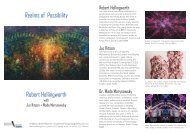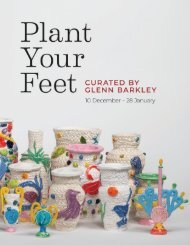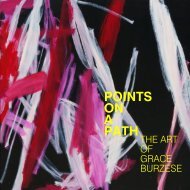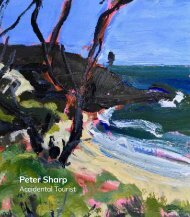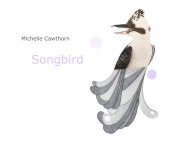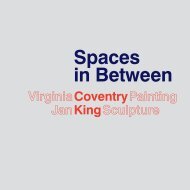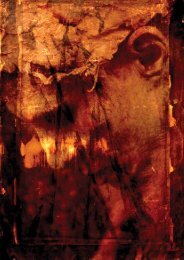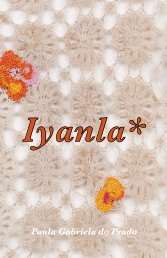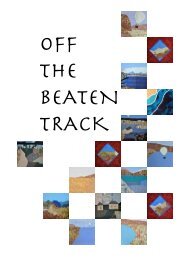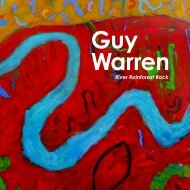Vicki Varvaressos | Painting in the Same Language: a different vocabulary
Vicki Varvaressos | Painting in the Same Language: a different vocabulary exhibition catalogue
Vicki Varvaressos | Painting in the Same Language: a different vocabulary exhibition catalogue
Create successful ePaper yourself
Turn your PDF publications into a flip-book with our unique Google optimized e-Paper software.
VICKI<br />
VARVARESSOS<br />
PAINTING IN THE SAME LANGUAGE:<br />
A DIFFERENT VOCABULARY
VICKI<br />
VARVARESSOS<br />
PAINTING IN THE SAME LANGUAGE:<br />
A DIFFERENT VOCABULARY<br />
PUBLICATION SPONSOR<br />
COVER IMAGE<br />
COUPLE (BLUE DRESS)<br />
1990 Acrylic on board 153x123cm
WOMAN WITH HANDS CLASPED<br />
1991 Acrylic on board 122x60cm<br />
INTRODUCTION<br />
<strong>Vicki</strong> <strong>Varvaressos</strong> is one of Australia’s lead<strong>in</strong>g established<br />
pa<strong>in</strong>ters, with works held <strong>in</strong> regional, state, national and<br />
<strong>in</strong>ternational collections. Despite this, her presence <strong>in</strong><br />
regional galleries <strong>in</strong> NSW is limited to representation <strong>in</strong> a<br />
number of collections, <strong>in</strong>clusion <strong>in</strong> group exhibitions and<br />
only one o<strong>the</strong>r major solo show; at Maitland Regional Art<br />
Gallery <strong>in</strong> 2014. This exhibition of works by <strong>Varvaressos</strong><br />
shows <strong>the</strong> breadth and variety of her art over <strong>the</strong> past<br />
40 years.<br />
Vavaressos studied at <strong>the</strong> National Art School <strong>in</strong> <strong>the</strong> early<br />
1970s, and her early works focused on figurative media<br />
representations of women and reflected contemporary<br />
fem<strong>in</strong>ist concerns. Her work cont<strong>in</strong>ued <strong>in</strong> a figurative style<br />
until early 1990 when her output eased its way <strong>in</strong>to abstraction<br />
with <strong>the</strong> first solo exhibition of <strong>the</strong>se works <strong>in</strong> 1991. S<strong>in</strong>ce <strong>the</strong>n<br />
<strong>Vicki</strong> has cont<strong>in</strong>ued to work <strong>in</strong> both styles, with some pa<strong>in</strong>t<strong>in</strong>gs<br />
seem<strong>in</strong>gly transition<strong>in</strong>g <strong>in</strong>-between. This exhibition has <strong>the</strong><br />
aim of <strong>in</strong>vestigat<strong>in</strong>g that slippage between <strong>the</strong> two styles, as<br />
well as look<strong>in</strong>g at <strong>the</strong> development of <strong>the</strong> artist over <strong>the</strong> 40<br />
year period. It looks at this art trajectory via twenty key works,<br />
with <strong>the</strong> earliest work produced <strong>in</strong> 1977 through to a work<br />
f<strong>in</strong>ished late 2017 and takes on board <strong>the</strong> artist’s own words,<br />
“abstraction is just a <strong>different</strong> pa<strong>in</strong>t<strong>in</strong>g <strong>vocabulary</strong> but it is <strong>the</strong><br />
same language” 1 .<br />
The exhibition also <strong>in</strong>troduces an artist whose art shows that<br />
<strong>the</strong>re is not a huge gulf between <strong>different</strong> styles and that lots<br />
of artists build bridges. Over time <strong>the</strong> artist’s figurative pieces<br />
have developed a less obvious political focus and as <strong>the</strong><br />
abstract elements evolved, both abstract and figurative styles<br />
have been explored and developed. It should be said though,<br />
that when pa<strong>in</strong>t<strong>in</strong>g <strong>Varvaressos</strong> does not always end up with<br />
<strong>the</strong> style of work conta<strong>in</strong>ed <strong>in</strong> <strong>the</strong> <strong>in</strong>itial germ of an idea; “I<br />
can suddenly change my m<strong>in</strong>d. If I am do<strong>in</strong>g an abstract and I<br />
can decide this is a figure and put a figure <strong>in</strong> or <strong>the</strong> o<strong>the</strong>r way<br />
around... it is where <strong>the</strong> pa<strong>in</strong>t<strong>in</strong>g takes you.“ 2<br />
The earliest works <strong>in</strong> <strong>the</strong> exhibition Bang Lang 1977, Re-th<strong>in</strong>k<br />
your face 1978 and “Why, Dr. Paget, what are you do<strong>in</strong>g<br />
here?“ said Rose. 1983 are examples of <strong>the</strong> artist’s early<br />
politically charged art with ‘<strong>in</strong> your face’ titles; <strong>the</strong> latter two<br />
from advertis<strong>in</strong>g and articles <strong>in</strong> magaz<strong>in</strong>es such as Woman’s<br />
Day; material that exploited and promoted an image of women<br />
as a blank canvas for cosmetics and fashion, material that<br />
deservedly was <strong>the</strong> subject of <strong>Varvaressos</strong>’s satire. Just out<br />
of <strong>the</strong> National Art School and rear<strong>in</strong>g to make a visual po<strong>in</strong>t;<br />
“These are pa<strong>in</strong>t<strong>in</strong>gs I pa<strong>in</strong>ted <strong>in</strong> my 20s and I have always felt<br />
that satire was a young person’s th<strong>in</strong>g and, as you get older,<br />
th<strong>in</strong>gs get more complex and <strong>in</strong>terest<strong>in</strong>g, <strong>in</strong> some ways and<br />
<strong>the</strong>re’s undercurrents and th<strong>in</strong>gs happen<strong>in</strong>g, and I change with<br />
that… I didn’t set out to make political statements but obviously<br />
those th<strong>in</strong>gs are reflected <strong>in</strong> what I was pa<strong>in</strong>t<strong>in</strong>g.” 3<br />
Over time <strong>the</strong> satire and <strong>the</strong> “message” have become less<br />
up-front while highlight<strong>in</strong>g human nature and <strong>the</strong> question of<br />
what it is to be human, <strong>in</strong>clud<strong>in</strong>g ways of th<strong>in</strong>k<strong>in</strong>g, feel<strong>in</strong>g, and<br />
act<strong>in</strong>g. “These questions are important because human nature<br />
can be regarded as both a source of normal conduct or ways<br />
of life, as well as present<strong>in</strong>g obstacles or constra<strong>in</strong>ts on liv<strong>in</strong>g<br />
a good life. A question of what it is to be human.” 4<br />
Even <strong>in</strong> <strong>the</strong> figurative pa<strong>in</strong>t<strong>in</strong>gs, <strong>the</strong> “figures” are put <strong>in</strong>to<br />
perspective, both emotionally and figuratively by a background<br />
of abstracted colour applied <strong>in</strong> confident brush strokes by<br />
an artist who obviously f<strong>in</strong>ds <strong>the</strong> act of pa<strong>in</strong>t<strong>in</strong>g a source of
BANG LANG<br />
1977 Acrylic on board 151x152cm<br />
immense satisfaction, even joy. In pa<strong>in</strong>t<strong>in</strong>gs such as Milky<br />
Figure 1989 and Couple (blue dress) 1990, <strong>the</strong> figuration while<br />
still strongly, humanly, emotive has merged with / become<br />
those broad brush strokes. “My works got broader and looser,<br />
those ones like… Mo<strong>the</strong>rhusk, that very much was perhaps<br />
just look<strong>in</strong>g at a blank canvas… <strong>the</strong> same with Couple (blue<br />
dress), <strong>the</strong>y’re very gestural, very physical but <strong>the</strong>y’re still.. I’m<br />
still pa<strong>in</strong>t<strong>in</strong>g what I’m <strong>in</strong>volved with at <strong>the</strong> time.” 5<br />
Yellow Tangle Tango 1991 and White Ribbon 1992, from <strong>the</strong><br />
period when <strong>Varvaressos</strong>’s first fully abstract exhibition was shown<br />
at Watters Gallery <strong>in</strong> Sydney (1991), are both very expressive,<br />
almost three dimensional, pa<strong>in</strong>t<strong>in</strong>gs that are so related to <strong>the</strong><br />
1993 Woman with th<strong>in</strong>g <strong>in</strong> <strong>the</strong> air that when you look from one<br />
to <strong>the</strong> o<strong>the</strong>r <strong>the</strong>re is no bridge to be built between abstract and<br />
figurative, <strong>the</strong>y are as <strong>in</strong>ter-related as <strong>the</strong> royal families of Europe.<br />
The suspicion is that <strong>the</strong> figuration aspects of Yellow Tangle<br />
Tango and White Ribbon just happen to be out of frame; both<br />
works carry <strong>the</strong> same human / emotional content as <strong>the</strong> more<br />
obviously figurative content of Woman with th<strong>in</strong>g <strong>in</strong> air.<br />
Miriam Craig, a COFA student, writ<strong>in</strong>g <strong>in</strong> ART WRITE, noted that<br />
<strong>in</strong> <strong>Varvaressos</strong>’s pa<strong>in</strong>t<strong>in</strong>gs <strong>the</strong>re is “a reflection of her keen<br />
passion for humanity. Relationships, <strong>in</strong>teractions and behaviours<br />
resonate <strong>in</strong> works that both confront and provoke. Whe<strong>the</strong>r<br />
politically charged or <strong>in</strong>timate and contemplative, <strong>Varvaressos</strong><br />
has used her art to comment on human experience <strong>in</strong> all its<br />
chaos and glory.” A wrench<strong>in</strong>g example of this comment<br />
is Woman with Dead Child 1994, a work that is hard to<br />
contemplate without an emotional catharsis.<br />
While <strong>Varvaressos</strong> <strong>in</strong>cludes portraiture <strong>in</strong> her oeuvre, and has<br />
won <strong>the</strong> Portia Geach Memorial Award <strong>in</strong> 2002 for her work<br />
Self portrait with pa<strong>in</strong>t<strong>in</strong>g, her facescape series, Face (green)<br />
1996 <strong>in</strong>cluded <strong>in</strong> this exhibition, reflects an <strong>in</strong>ternal exploration<br />
of <strong>the</strong> face, “what I’ve always been <strong>in</strong>terested <strong>in</strong>, is space and<br />
even if it is <strong>the</strong> face, I’ve always wanted to break it up and sort<br />
of travel through it... <strong>the</strong>re are landscapes <strong>in</strong> those faces, that is<br />
why I call <strong>the</strong>m face-scapes.” 6 As Marcel Proust noted 7 , “ The<br />
world of <strong>the</strong> possible is more extensive than <strong>the</strong> real world.”<br />
<strong>Varvaressos</strong>’s <strong>in</strong>ternal explorations create worlds that are richer<br />
than reality; <strong>the</strong>re is no need for people to pose or for objects<br />
to be set up <strong>in</strong> front of <strong>the</strong> easel.
Over time <strong>the</strong> artist has developed and become more subtle,<br />
<strong>the</strong> figurative works are less manipulative, <strong>the</strong> mean<strong>in</strong>g and<br />
<strong>in</strong>terpretation more a matter for <strong>the</strong> viewer. <strong>Varvaressos</strong><br />
becomes <strong>the</strong> silent observer who distances herself from <strong>the</strong><br />
condemn<strong>in</strong>g confrontation of previous years. She now uses<br />
her art to explore ra<strong>the</strong>r than expose. 8 In L<strong>in</strong>gerie Torsos<br />
2004, from <strong>the</strong> “Dolls and Figures” exhibition held at Watters<br />
Gallery <strong>in</strong> 2005, <strong>the</strong> two figures have ei<strong>the</strong>r a blank faced<br />
stare or downcast eyes, requir<strong>in</strong>g <strong>the</strong> viewer to fill <strong>in</strong> <strong>the</strong>ir own<br />
<strong>in</strong>terpretation. Later abstract works such as Lavender Block<br />
2017 and Gumgrey 2017, while still reflect<strong>in</strong>g an emotional<br />
approach and joy <strong>in</strong> <strong>the</strong> act of pa<strong>in</strong>t<strong>in</strong>g are less full, <strong>the</strong> content<br />
pared down, compared to Yellow Tangle Tango and White<br />
Ribbon from some 25 years previous.<br />
The exhibition also <strong>in</strong>cludes a very recent work, Cat <strong>Pa<strong>in</strong>t<strong>in</strong>g</strong><br />
2017, which <strong>in</strong> fact was still on <strong>the</strong> easel when I first visited <strong>the</strong><br />
artist to start <strong>the</strong> curatorial <strong>in</strong>vestigation <strong>in</strong>to a long and very<br />
dist<strong>in</strong>guished artistic life. The cat, a command<strong>in</strong>g presence<br />
beside an enigmatic woman, and <strong>the</strong> drama of limited colour,<br />
provide all <strong>the</strong> visual <strong>in</strong>formation required for <strong>the</strong> viewer to<br />
complete <strong>the</strong>ir own narrative. I immediately requested that it be<br />
<strong>in</strong>cluded <strong>in</strong> this survey; a request that was granted.<br />
With a history of exhibit<strong>in</strong>g <strong>the</strong> works of contemporary Australian<br />
artists, and a strong focus on female artists, Shoalhaven<br />
Regional Gallery cont<strong>in</strong>ues to build its exhibition program<br />
through exhibitions of <strong>the</strong> works of artists such as Margaret<br />
Dredge and Elisabeth Cumm<strong>in</strong>gs and group shows that <strong>in</strong>clude<br />
works by Bronwyn Oliver, Grace Burzese, Rachel Douglas, Aida<br />
Tomescu and many o<strong>the</strong>rs. This exhibition is well positioned<br />
to ensure <strong>the</strong> successful reception of <strong>Varvaressos</strong>’ works with<br />
our audience, and <strong>the</strong> catalogue is of course also crucial for<br />
<strong>in</strong>creas<strong>in</strong>g understand<strong>in</strong>g of <strong>the</strong> artist, her art and <strong>in</strong> gett<strong>in</strong>g<br />
<strong>in</strong>sights <strong>in</strong>to an open m<strong>in</strong>ded approach to art and various styles.<br />
Ra<strong>the</strong>r than just a survey over a period this way of look<strong>in</strong>g at<br />
<strong>Vicki</strong> <strong>Varvaressos</strong>’s art; <strong>in</strong>vestigat<strong>in</strong>g <strong>the</strong> slippage between<br />
two styles, figurative and abstraction, as well as look<strong>in</strong>g at<br />
development of <strong>the</strong> artist over <strong>the</strong> 40 year period, adds to State<br />
and National dialogue, exhibitions and representations, and will<br />
stand as a reference for future research.<br />
MAX DINGLE<br />
Curator<br />
September 2018<br />
Max D<strong>in</strong>gle is an artist, curator and writer based <strong>in</strong> <strong>the</strong><br />
Shoalhaven. He studied at <strong>the</strong> National Art School <strong>in</strong><br />
Darl<strong>in</strong>ghurst <strong>in</strong> <strong>the</strong> early 1970s and also had a twenty five<br />
year career work<strong>in</strong>g at <strong>the</strong> Australian Museum and <strong>the</strong><br />
Australian National Maritime Museum before focus<strong>in</strong>g on<br />
his own art practice as well as volunteer curatorial work<br />
for <strong>the</strong> Shoalhaven Regional Gallery, Nowra.<br />
ENDNOTES<br />
1 Artist quote - Tracey Clement “ArtGuide” May 2017<br />
2 Artist quote - Joe Eisenberg “<strong>Vicki</strong> <strong>Varvaressos</strong>: <strong>the</strong> story so far” 2014 ISBN978.0.9874919.9.2<br />
3 Artist quote - Joe Eisenberg “<strong>Vicki</strong> <strong>Varvaressos</strong>: <strong>the</strong> story so far” 2014 ISBN978.0.9874919.9.2<br />
4 C. D. C. Reeve “Political Theory” Vol. 27, No. 4 (Aug., 1999), pp. 435-446<br />
5 Artist quote - Joe Eisenberg “<strong>Vicki</strong> <strong>Varvaressos</strong>: <strong>the</strong> story so far” 2014 ISBN978.0.9874919.9.2<br />
6 Artist quote - Joe Eisenberg “<strong>Vicki</strong> <strong>Varvaressos</strong>: <strong>the</strong> story so far” 2014 ISBN978.0.9874919.9.2<br />
7 Proust to Violet Schiff – ‘ Night at <strong>the</strong> Majestic’ , R Davenport-H<strong>in</strong>es Faber ISBN<br />
978.0.571.22009.0<br />
8 Geoffrey Legge, Director, Watters Gallery
LINGERIE TORSOS<br />
2004 Acrylic on canvas 122x107cm<br />
VICKI<br />
VARVARESSOS<br />
When <strong>Vicki</strong> <strong>Varvaressos</strong> enrolled <strong>in</strong> <strong>the</strong> National Art School <strong>in</strong><br />
Darl<strong>in</strong>ghurst, only a short distance from her childhood home<br />
of Bellevue Hill, It was like enter<strong>in</strong>g ano<strong>the</strong>r world. In 1970<br />
Sydney’s <strong>in</strong>ner city was commonly regarded as a slum. Her<br />
childhood had been spent <strong>in</strong> Bellevue Hill, a neighbourhood of<br />
large freestand<strong>in</strong>g houses embedded <strong>in</strong> magnificent gardens.<br />
She was soon <strong>in</strong>troduced to narrow streets with few trees,<br />
terrace houses, cramped flats, public drunkenness, street<br />
prostitution, and o<strong>the</strong>r open manifestations of poverty. But<br />
<strong>the</strong>re was a vitality miss<strong>in</strong>g from suburbia. She soon moved<br />
to digs nearby and became one of <strong>the</strong> activists try<strong>in</strong>g to save<br />
<strong>the</strong> city from <strong>the</strong> developers who saw derelict houses as an<br />
opportunity to build high rise luxury apartments and reshape<br />
<strong>the</strong> <strong>in</strong>ner city away from bohemian grunge. She jo<strong>in</strong>ed <strong>the</strong><br />
Darl<strong>in</strong>ghurst Residents Action Group, work<strong>in</strong>g with o<strong>the</strong>r artists<br />
who were mak<strong>in</strong>g posters and o<strong>the</strong>r visual protests.<br />
At <strong>the</strong> National Art School, <strong>the</strong> overwhelm<strong>in</strong>g majority of students<br />
were women, but only <strong>the</strong> male students were treated with<br />
respect by both <strong>the</strong> <strong>in</strong>stitution and most of <strong>the</strong> teach<strong>in</strong>g staff. The<br />
widespread assumption was that unless <strong>the</strong>y were plann<strong>in</strong>g on<br />
becom<strong>in</strong>g school teachers, <strong>the</strong> women students had enrolled <strong>in</strong><br />
art as a faux bohemian f<strong>in</strong>ish<strong>in</strong>g school before settl<strong>in</strong>g down as<br />
wives of ei<strong>the</strong>r “real” artists or professional men.<br />
In <strong>Varvaressos</strong>’s memory most of <strong>the</strong> artists who were teach<strong>in</strong>g<br />
at <strong>the</strong> National Art School were more concerned with <strong>the</strong>ir<br />
own professional careers and did not see <strong>the</strong> need to do<br />
much more than express mild approval at student efforts. The<br />
one exception was Peter Blayney. “He was one of <strong>the</strong> few<br />
who were actually professional, who took <strong>the</strong> job seriously,”<br />
<strong>Varvaressos</strong> recalls. “I remember Peter would talk to you, look<br />
at your work – and talk to you as though you were an artist,<br />
not just as though you were one of <strong>the</strong> female members of <strong>the</strong><br />
class.” Blayney’s highly f<strong>in</strong>ished allegorical pa<strong>in</strong>t<strong>in</strong>gs, with <strong>the</strong>ir<br />
references to art historical precedents, bear no resemblance<br />
to <strong>the</strong> work his students produced. His importance to<br />
<strong>Varvaressos</strong> and o<strong>the</strong>r students he taught was <strong>the</strong> respect he<br />
gave to <strong>the</strong>m, <strong>the</strong> suggestion that <strong>the</strong>se early efforts may well<br />
be <strong>the</strong> first steps <strong>in</strong> a dist<strong>in</strong>guished career. Years later <strong>in</strong> <strong>the</strong><br />
mid-1980s, when she was teach<strong>in</strong>g at <strong>the</strong> City Art Institute, she<br />
<strong>in</strong> turn became a similar <strong>in</strong>fluence on a younger generation of<br />
artists whose work looked noth<strong>in</strong>g like her own.
It is hard to expla<strong>in</strong> to younger generations <strong>the</strong> all-pervasive<br />
meant that for many years <strong>the</strong>y led a decidedly f<strong>in</strong>ancially<br />
deaden<strong>in</strong>g form of employment when <strong>the</strong> weaver Margaret<br />
Liv<strong>in</strong>g so close to <strong>the</strong> centre of all that was passionate and<br />
prejudice aga<strong>in</strong>st women artists that persisted from <strong>the</strong><br />
precarious existence.<br />
Grafton, who she knew from <strong>the</strong> Darl<strong>in</strong>ghurst Residents Action<br />
political, it was understandable that her first exhibition was<br />
1940s until <strong>the</strong> mid-1970s, when <strong>the</strong> visual arts establishment<br />
belatedly felt <strong>the</strong> impact of second-wave Fem<strong>in</strong>ism. The<br />
assumption that women artists were without value was so<br />
entrenched at <strong>the</strong> National Art School that one year when <strong>the</strong><br />
judges for <strong>the</strong> annual prize for <strong>the</strong> top graduat<strong>in</strong>g student saw<br />
<strong>the</strong>re were two equally graded contenders (and one was a<br />
woman), <strong>the</strong> prize was given to <strong>the</strong> man – “because he was<br />
gett<strong>in</strong>g married, and he’d need <strong>the</strong> money”. In 1973 <strong>the</strong> Art<br />
Gallery of New South Wales presented Recent Australian Art,<br />
a major survey to celebrate <strong>the</strong> open<strong>in</strong>g of <strong>the</strong> Sydney Opera<br />
House. It showed <strong>the</strong> best and brightest, <strong>the</strong> newest and<br />
freshest of Australian art. There were forty-six artists, only one<br />
of whom was a woman.<br />
As with most women of her generation, <strong>Vicki</strong> <strong>Varvaressos</strong><br />
married young, when she was 22. Her husband, Paul Redd<strong>in</strong>g,<br />
was at first a medical student who was less than happy<br />
<strong>in</strong> his studies. With <strong>Varvaressos</strong>’s encouragement he left<br />
medic<strong>in</strong>e and enrolled <strong>in</strong> a degree <strong>in</strong> philosophy, which led<br />
to a dist<strong>in</strong>guished academic career. This change of direction<br />
As she completed her time at <strong>the</strong> National Art School, <strong>Vicki</strong><br />
<strong>Varvaressos</strong> considered her future. Graduates were be<strong>in</strong>g<br />
encouraged to go to <strong>the</strong> Alexander Mackie College and<br />
become high school art teachers. Although <strong>the</strong> <strong>in</strong>come was<br />
tempt<strong>in</strong>g <strong>Varvaressos</strong> rejected this path as she realised that “if<br />
I went down that path, I’d never pa<strong>in</strong>t”, and by <strong>the</strong>n she knew<br />
this was <strong>the</strong> path she needed to follow. Instead she looked for<br />
odd jobs that would still give her <strong>the</strong> time and energy to pa<strong>in</strong>t.<br />
One of those jobs was to <strong>in</strong>fluence <strong>the</strong> way she considered<br />
<strong>the</strong> presentation of fashion and through this, her art. She was<br />
liv<strong>in</strong>g <strong>in</strong> Baptist Street, <strong>in</strong> Redfern and an advertisement <strong>in</strong> <strong>the</strong><br />
local paper asked for someone to repurpose goods from a<br />
department store. “It was a subsidiary of David Jones, but <strong>the</strong>y<br />
were department stores <strong>in</strong> rural areas and Canberra and <strong>the</strong>y<br />
were called Miser Jones,” she says. “My job was putt<strong>in</strong>g those<br />
awful plastic th<strong>in</strong>gs on items, just stabb<strong>in</strong>g <strong>the</strong>m with a plastic<br />
gun.” It was not <strong>the</strong> k<strong>in</strong>d of employment designed to give faith<br />
<strong>in</strong> <strong>the</strong> consumer society. She escaped from this particularly<br />
Group, was awarded a grant to develop a major tapestry<br />
commission and asked <strong>Varvaressos</strong> to become her studio<br />
assistant.<br />
She was liv<strong>in</strong>g <strong>in</strong> Victoria Street at K<strong>in</strong>gs Cross when<br />
developers determ<strong>in</strong>ed to demolish <strong>the</strong> old houses to build<br />
skyscrapers along <strong>the</strong> escarpment. The tactics <strong>the</strong>y used<br />
were best described as brutal. <strong>Varvaressos</strong> became active <strong>in</strong><br />
<strong>the</strong> Green Bans movement, determ<strong>in</strong>ed to save <strong>in</strong>ner Sydney<br />
from developers as money comb<strong>in</strong>ed with political power and<br />
crim<strong>in</strong>al <strong>in</strong>tent. Many of <strong>the</strong> activists were mak<strong>in</strong>g silk screen<br />
posters to spread <strong>the</strong>ir messages, but her medium has always<br />
been pa<strong>in</strong>t. She relished <strong>the</strong> tactile quality of <strong>the</strong> medium, <strong>the</strong><br />
way that big sweep<strong>in</strong>g brush strokes can evoke mood as well<br />
as image as she comb<strong>in</strong>ed social critique and a pa<strong>in</strong>terly style.<br />
These early pa<strong>in</strong>t<strong>in</strong>gs comb<strong>in</strong>ed acute commentary with a<br />
passionate expressive treatment <strong>in</strong> <strong>in</strong>tense pigments. “It was<br />
<strong>the</strong> only way that I could still express th<strong>in</strong>gs that were go<strong>in</strong>g on<br />
was to use images”, she recalls.<br />
at Watters Gallery, at Riley Street <strong>in</strong> Darl<strong>in</strong>ghurst. At <strong>the</strong> time<br />
Watters was Australia’s lead<strong>in</strong>g avant garde art gallery. Its<br />
formidable reputation came from <strong>the</strong> way that Frank Watters<br />
and Geoffrey Legge rema<strong>in</strong>ed open to new ideas and<br />
experiences, which <strong>in</strong>cluded be<strong>in</strong>g prepared to look at <strong>the</strong> art<br />
of unknown young artists.<br />
Daniel Thomas, <strong>the</strong> most <strong>in</strong>fluential curator at <strong>the</strong> Art Gallery of<br />
New South Wales who also had a small column <strong>in</strong> <strong>the</strong> Sydney<br />
Morn<strong>in</strong>g Herald, did not usually write on an artist’s first solo<br />
exhibition but he noted that <strong>Varvaressos</strong>’s work showed<br />
“devastat<strong>in</strong>g <strong>in</strong>dividual observations of ethnic Sydney types,<br />
men <strong>in</strong> ugly moustaches.”<br />
The month of her exhibition co<strong>in</strong>cided with an event that<br />
showed <strong>Varvaressos</strong> a darker side of Sydney as Juanita<br />
Nielsen, who had fought to save Victoria Street vanished,<br />
believed murdered on <strong>the</strong> orders of people unnamed. “It<br />
was horrible, horrible,” she says. “I can’t believe <strong>the</strong> idea that<br />
a woman could be murdered for object<strong>in</strong>g to development.
CAT PAINTING<br />
2017 Acrylic on canvas 122x122cm<br />
And <strong>the</strong>n at <strong>the</strong> same time, Wendy Bacon and Teresa Brennan,<br />
I th<strong>in</strong>k <strong>the</strong>y were sent bullets <strong>in</strong> <strong>the</strong> mail.” In <strong>the</strong> heightened<br />
<strong>in</strong>tensity of <strong>the</strong> times, <strong>the</strong> images of <strong>the</strong> artificially constructed<br />
society that became fodder for her art, were reflected <strong>in</strong> <strong>the</strong><br />
<strong>in</strong>tensity of her colours – hot p<strong>in</strong>k, <strong>in</strong>tense greens and pure<br />
turquoise. In broad descriptive strokes she mocked <strong>the</strong> l<strong>in</strong>es<br />
of advertis<strong>in</strong>g <strong>in</strong> women’s magaz<strong>in</strong>es – Make your face <strong>the</strong><br />
focal po<strong>in</strong>t this season shows a woman exam<strong>in</strong><strong>in</strong>g her image<br />
<strong>in</strong> <strong>the</strong> mirror while to one side a figure quot<strong>in</strong>g one of Ingres’<br />
portraits calmly contemplates eternity.<br />
Her second exhibition drew on <strong>the</strong> contrast between <strong>the</strong><br />
image and <strong>the</strong> substance, which was noted by <strong>the</strong> critic<br />
Sandra McGrath who wrote <strong>in</strong> The Australian:<br />
Technically she uses a loose, pa<strong>in</strong>terly, almost De<br />
Koon<strong>in</strong>gesque brushwork with which she renders<br />
expressionistic faces or figures <strong>in</strong> crowds.<br />
There are quasi-portraits of Bob Hawke, Fraser,<br />
Kerr and Pr<strong>in</strong>cess Grace. But unlike some of Larter’s<br />
early pop political satire, <strong>the</strong> effect is not direct…<br />
Nancy Borlase, writ<strong>in</strong>g <strong>in</strong> <strong>the</strong> Sydney Morn<strong>in</strong>g Herald, also<br />
likened her deliberately rough pa<strong>in</strong>terly approach to that of<br />
De Koon<strong>in</strong>g, and while she was wary of <strong>Varvaressos</strong>’ politically<br />
aware subject matter she admired her wit, writ<strong>in</strong>g:<br />
Her pa<strong>in</strong>t<strong>in</strong>gs are of pimps, p<strong>in</strong>-ups, policemen,<br />
protesters (with whom she has an obvious rapport),<br />
politicians and prostitutes of all k<strong>in</strong>ds, depend<strong>in</strong>g<br />
on how broadly one <strong>in</strong>terprets <strong>the</strong> term. Her faces<br />
are public masks and private exposures, her<br />
message is political but with a sense of humour.<br />
Borlase had called <strong>Varvaressos</strong> a “young develop<strong>in</strong>g artist”,<br />
and <strong>in</strong> 1978 she was able to add depth to her knowledge of art<br />
and <strong>the</strong> world when <strong>the</strong>y moved to Paris where her husband<br />
was undertak<strong>in</strong>g postgraduate research. On return<strong>in</strong>g to<br />
Sydney <strong>the</strong>y lived <strong>in</strong> Clapton Place <strong>in</strong> Darl<strong>in</strong>ghurst, just opposite<br />
<strong>the</strong> car park for <strong>the</strong> old ABC build<strong>in</strong>g. Although <strong>the</strong> apartment<br />
was small <strong>the</strong>re was a balcony where she grew sp<strong>in</strong>ach. It was<br />
a rem<strong>in</strong>der that when she was child she had always enjoyed<br />
be<strong>in</strong>g <strong>in</strong> <strong>the</strong> garden, grow<strong>in</strong>g th<strong>in</strong>gs. Plants and flowers began<br />
to appear <strong>in</strong> her work, a cont<strong>in</strong>u<strong>in</strong>g rem<strong>in</strong>der of <strong>the</strong> importance<br />
of <strong>the</strong> natural world.
The first major critique of <strong>Varvaressos</strong>’s work was written by<br />
<strong>the</strong> fem<strong>in</strong>ist art historian Jan<strong>in</strong>e Burke and published <strong>in</strong> Art<br />
and Australia <strong>in</strong> 1982. The cover image was a close-up detail<br />
of her satirical exam<strong>in</strong>ation of <strong>the</strong> media creation of fem<strong>in</strong><strong>in</strong>ity,<br />
Easy Go<strong>in</strong>g Hostess. Burke saw Vavaressos as an artist whose<br />
work sprang from “a controlled anger”, an assessment that is<br />
disputed by <strong>the</strong> artist. “Maybe it was my gesture she found<br />
angry, or maybe <strong>the</strong> fact that <strong>the</strong> th<strong>in</strong>gs I was talk<strong>in</strong>g about, I was<br />
concerned about” she says. “Like those titles that you’d f<strong>in</strong>d<br />
<strong>in</strong> women’s magaz<strong>in</strong>es, <strong>the</strong> nonsense <strong>in</strong> just pick<strong>in</strong>g up those<br />
th<strong>in</strong>gs, but not anger.”<br />
Popular media cont<strong>in</strong>ued to be a source of nourishment, but as<br />
her work matured she gradually moved towards more <strong>in</strong>ternal<br />
and contemplative pa<strong>in</strong>t<strong>in</strong>gs. Her fluid brushstrokes became<br />
looser, almost gestural – and <strong>the</strong>n transformed <strong>in</strong>to abstraction.<br />
When she first showed Frank Watters this new direction <strong>in</strong> her<br />
art, “I told him that maybe I’d perhaps always been a repressed<br />
Abstract Expressionist.”<br />
Her abstract pa<strong>in</strong>t<strong>in</strong>gs where <strong>the</strong> first gestural stroke can lead<br />
to a work tak<strong>in</strong>g on a life of its own, are pa<strong>in</strong>ted <strong>in</strong> tandem with<br />
her cont<strong>in</strong>ued fasc<strong>in</strong>ation with <strong>the</strong> human figure, especially<br />
<strong>the</strong> face. “Every now and <strong>the</strong>n you just want to come back<br />
to <strong>the</strong> human,” she says. The human body gives a sense of<br />
structure <strong>in</strong> compos<strong>in</strong>g a pa<strong>in</strong>t<strong>in</strong>g, but <strong>the</strong>n abstract art has its<br />
own enticements, especially <strong>the</strong> sense of start<strong>in</strong>g a work with<br />
a s<strong>in</strong>gle stroke of <strong>the</strong> brush, and not know<strong>in</strong>g where it will end<br />
up. She has often spoken of <strong>the</strong> need to dive right <strong>in</strong>to <strong>the</strong> work<br />
without preparatory sketches or draw<strong>in</strong>g. In her pa<strong>in</strong>t<strong>in</strong>gs such<br />
as Yellow Tangle Tango, pa<strong>in</strong>t lead and swirls, show<strong>in</strong>g a relish<br />
for <strong>the</strong> contrast of colour and l<strong>in</strong>e. O<strong>the</strong>r abstracts are more<br />
meditative, quieter considerations of how shape and colour<br />
may work toge<strong>the</strong>r <strong>in</strong> harmony.<br />
Sometimes <strong>the</strong> simplified shapes of her figurative pa<strong>in</strong>t<strong>in</strong>gs<br />
achieve an almost Joy Hester-like apparent simplicity, where<br />
a s<strong>in</strong>gle brush stroke can evoke moods like <strong>the</strong> yearn<strong>in</strong>g of<br />
bodies <strong>in</strong> tandem <strong>in</strong> Couple (blue dress) where <strong>the</strong> woman<br />
arches as she yields to <strong>the</strong> man’s embrace, <strong>the</strong> stark def<strong>in</strong>ition<br />
of Milky Figure, or <strong>the</strong> <strong>in</strong>tense gaze of Facescape (plum).<br />
When she comes to pa<strong>in</strong>t her self-portraits she does not wish to<br />
dom<strong>in</strong>ate <strong>the</strong> composition. This can be seen most effectively <strong>in</strong><br />
<strong>the</strong> pa<strong>in</strong>t<strong>in</strong>g that won <strong>the</strong> 2002 Portia Geach Prize, Self-portrait<br />
with pa<strong>in</strong>t<strong>in</strong>g, which is both a tribute to a much loved pa<strong>in</strong>t<strong>in</strong>g<br />
she had sold and a study of <strong>the</strong> artist’s relationship to <strong>the</strong> work<br />
she has made.<br />
As her pa<strong>in</strong>t<strong>in</strong>gs have evolved over <strong>the</strong> years, so too have<br />
her colours changed. The tones became darker, and <strong>the</strong>n<br />
sometimes pastel light, but always more muted. In her most<br />
recent pa<strong>in</strong>t<strong>in</strong>gs <strong>the</strong>re is no sense of <strong>the</strong> concentration of colour<br />
that characterised her first exhibitions<br />
“You don’t notice changes <strong>in</strong> your work,” she says.” I remember<br />
be<strong>in</strong>g shocked look<strong>in</strong>g at my early work. The colour! It was so<br />
<strong>in</strong>tense, those hot p<strong>in</strong>ks and reds and th<strong>in</strong>gs.”<br />
In 2010, after many years of liv<strong>in</strong>g <strong>in</strong> terrace houses,<br />
<strong>Varvaressos</strong> f<strong>in</strong>ally achieved a house with a large backyard,<br />
which she has transformed <strong>in</strong>to a magical garden.<br />
Her pa<strong>in</strong>t<strong>in</strong>gs have always shown a sense of exchange<br />
between art and nature. Sometimes this may be with flowers,<br />
as <strong>in</strong> <strong>the</strong> enigmatic Self-portrait with protea and pa<strong>in</strong>t<strong>in</strong>gs.<br />
O<strong>the</strong>rs are more conventional still lives, but always <strong>the</strong>re is<br />
a sense of <strong>the</strong> cont<strong>in</strong>ual <strong>in</strong>terchange between natural world<br />
and <strong>the</strong> human psyche.<br />
JOANNA MENDELSSOHN<br />
Joanna Mendelssohn began her professional career<br />
at <strong>the</strong> Art Gallery of New South Wales and later worked<br />
for <strong>the</strong> Newcastle Region Art Gallery and <strong>the</strong> S.H. Erv<strong>in</strong><br />
Museum and Art Gallery. As <strong>the</strong> award-w<strong>in</strong>n<strong>in</strong>g art critic<br />
for The Bullet<strong>in</strong> and <strong>in</strong> o<strong>the</strong>r publications she has written<br />
extensively on Australian art <strong>in</strong>clud<strong>in</strong>g for The Conversation<br />
and was one of <strong>the</strong> <strong>in</strong>stigators of Design & Art Onl<strong>in</strong>e<br />
(www.daao.org.au). Her previous books <strong>in</strong>clude The life &<br />
work of Sydney Long (1979), Lionel L<strong>in</strong>dsay: An artist and<br />
his family 1988) and Letters & Liars: Norman L<strong>in</strong>dsay and<br />
<strong>the</strong> L<strong>in</strong>dsay Family (1996). She is currently an honorary<br />
associate professor at UNSW Art & Design, where she was<br />
for many years Program Director for Art Adm<strong>in</strong>istration.<br />
Her most recent book is Australian Art Exhibitions:<br />
Open<strong>in</strong>g Our Eyes (Thames and Hudson 2018) which<br />
she co-authored with Ca<strong>the</strong>r<strong>in</strong>e De Lorenzo, Ca<strong>the</strong>r<strong>in</strong>e<br />
Speck and Alison Inglis.<br />
ENDNOTES<br />
*Quotations are from <strong>the</strong> author’s <strong>in</strong>terview with <strong>Vicki</strong> <strong>Varvaressos</strong> <strong>in</strong> July 2018.
VICKI<br />
VARVARESSOS<br />
PAINTING IN THE SAME LANGUAGE:<br />
A DIFFERENT VOCABULARY
LEFT<br />
BANG LANG<br />
1977 Acrylic on board 151x152cm<br />
RIGHT<br />
“WHY, DR PAGET, WHAT ARE YOU<br />
DOING HERE?” SAID ROSE<br />
1983 Acrylic on canvas 126x174cm
RE-THINK YOUR FACE<br />
1978 Acrylic collage on l<strong>in</strong>en 78x201cm
LEFT<br />
TWO FIGURES (CHILD)<br />
1989 Oil on board 137x122cm<br />
RIGHT<br />
MOTHERHUSK<br />
1989 Oil on board 135x122cm
MILKY FIGURE<br />
1989 Acrylic on board 152x122cm<br />
COUPLE (BLUE DRESS)<br />
1990 Acrylic on board 153x123cm
WOMAN WITH HANDS CLASPED<br />
1991 Acrylic on board 122x60cm<br />
YELLOW TANGLE TANGO<br />
1991 Acrylic on board 115x157cm
LEFT<br />
WHITE RIBBON<br />
1992 Acrylic on canvas 122x137cm<br />
RIGHT<br />
WOMAN WITH THING IN THE AIR<br />
1993 Acrylic on board 138x122cm
LEFT<br />
WOMAN WITH DEAD CHILD<br />
1994 Acrylic and oil on board 137x122cm<br />
RIGHT<br />
FACE (GREEN)<br />
1996 Acrylic on canvas 61x61cm<br />
PAGE OVER<br />
BLACK SUN TRIPTYCH<br />
2001 Acrylic on canvas 122x275cm
LINGERIE TORSOS<br />
2004 Acrylic on canvas 122x107cm<br />
SILVER SQUARE<br />
2006 Acrylic on canvas 137x107cm
LEFT<br />
BLUE TANG<br />
2015 Acrylic on canvas 122x92cm<br />
RIGHT<br />
CAT PAINTING<br />
2017 Acrylic on canvas 122x122cm
LEFT<br />
GUMGREY<br />
2017 Acrylic on canvas 102x102cm<br />
RIGHT<br />
LAVENDER BLOCK<br />
2017 Acrylic on canvas 122x92cm
CURRICULUM<br />
VITAE<br />
VICKI VARVARESSOS<br />
SOLO EXHIBITIONS<br />
COLLECTIONS<br />
Born, 1949, Sydney<br />
From 1975 to 2016<br />
Watters Gallery, Sydney.<br />
National Gallery of Australia<br />
National Gallery of Victoria<br />
Art Gallery of New South Wales<br />
STUDIED<br />
1970-73 Studied National Art School, Sydney<br />
1980, 1981 Stuart Gerstman Galleries, Melbourne.<br />
From 1986 to 1998<br />
Niagara Gallery, Melbourne.<br />
Art Gallery of Western Australia<br />
National Gallery, New Zealand<br />
Queensland Art Gallery<br />
University of Tasmania<br />
Art Gallery of South Australia<br />
Allen Arthur Rob<strong>in</strong>son<br />
SELECTED GROUP EXHIBITIONS<br />
Gold Coast City Art Gallery<br />
Shepparton Art Gallery<br />
Chartwell Collection, New Zealand<br />
1981 Australian Perspecta, Art Gallery of New South<br />
Wales, Sydney.<br />
1991 Her Story: Images of Domestic Labour <strong>in</strong><br />
Australian Art, S. H. Erv<strong>in</strong> Gallery, Sydney.<br />
University of New South Wales<br />
University of Queensland<br />
Heide Museum of Modern Art<br />
1982 Australian <strong>Pa<strong>in</strong>t<strong>in</strong>g</strong> and Sculpture 1956–1981:<br />
Survey from <strong>the</strong> Collection, Art Gallery of New<br />
South Wales, Sydney.<br />
1984 Private Symbol: Social Metaphor, 5 th Biennale of<br />
Sydney, Art Gallery of New South Wales, Sydney.<br />
1995 In <strong>the</strong> Company of Women, 100 years of<br />
Australian women’s Art from <strong>the</strong> Cru<strong>the</strong>rs<br />
Collection, Perth Institute of Contemporary Arts.<br />
1997 A Face <strong>in</strong> <strong>the</strong> Crowd, National Portrait Gallery,<br />
Canberra.<br />
Geelong ArtGallery<br />
Wollongong Art Gallery<br />
Baker & McKenzie<br />
Artbank<br />
New Parliament House, Canberra<br />
IBM<br />
Warrnambool Art Gallery<br />
Woollahra City Council<br />
Wagga Wagga City Art Gallery<br />
1985 Australian Perspecta ’85, Art Gallery of New<br />
South Wales, Sydney.<br />
1987 Art <strong>in</strong> Architecture: Selections from <strong>the</strong><br />
New Parliament House Collection, Canberra<br />
Contemporary Art Gallery.<br />
1988 Bicentennial Pr<strong>in</strong>t Folio, Australian National<br />
Gallery, Canberra.<br />
1999 The Innovators, S. H. Erv<strong>in</strong> Gallery, Sydney.<br />
2002 Contemporary Australian Portraits, National<br />
Portrait Gallery, Canberra Portia Geach Memorial<br />
Award W<strong>in</strong>ner, S. H. Irv<strong>in</strong>.<br />
2010 Slow Burn – a century of Australian Women<br />
artists, S. H. Irv<strong>in</strong>.<br />
Western M<strong>in</strong><strong>in</strong>g<br />
Orange Regional Gallery<br />
Joseph Brown Collection<br />
Moree Pla<strong>in</strong>s Gallery<br />
Newcastle Regional Art Gallery<br />
Maitland Regional Art Gallery
ACKNOWLEDGEMENTS<br />
Shoalhaven Regional Gallery would like<br />
to thank all those who have contributed<br />
to this exhibition.<br />
Thank you to <strong>the</strong> curator, Max D<strong>in</strong>gle<br />
who cont<strong>in</strong>ues to volunteer his<br />
extensive knowledge and expertise to<br />
<strong>the</strong> Gallery. His exhibitions are always<br />
thoughtful, <strong>in</strong>sightful and br<strong>in</strong>g us new<br />
artists and opportunities to engage <strong>in</strong><br />
new ways.<br />
To <strong>the</strong> artist, <strong>Vicki</strong> <strong>Varvaressos</strong>, Watters<br />
Gallery and particularly Ian Gunn,<br />
Geoffrey Legge and Frank Watters for<br />
open<strong>in</strong>g <strong>the</strong>ir archives and allow<strong>in</strong>g us<br />
to access works created over 40 years.<br />
Thank you to Honorary Assoc. Professor<br />
Joanna Mendelssohn for her essay.<br />
This piece gives great consideration<br />
and understand<strong>in</strong>g to <strong>the</strong> artist and <strong>the</strong><br />
works with<strong>in</strong> <strong>the</strong> exhibition.<br />
Thank you also to those who have<br />
helped br<strong>in</strong>g this catalogue toge<strong>the</strong>r<br />
Design: Burnt Phoenix<br />
Pr<strong>in</strong>t: Ulladulla Pr<strong>in</strong>t Services<br />
Publication Sponsor:<br />
Gordon Darl<strong>in</strong>g Foundation<br />
Images courtesy Max D<strong>in</strong>gle<br />
ISBN 978-0-6483014-2-4<br />
All rights reserved. No part of this publication<br />
may be reproduced or transmitted <strong>in</strong> any form or<br />
by any means, electronic or mechanical, without<br />
<strong>the</strong> prior permission from <strong>the</strong> publisher o<strong>the</strong>r than<br />
that permitted under <strong>the</strong> Copyright Act 1968 and<br />
subsequent amendments.<br />
© Shoalhaven Regional Gallery, Nowra 2018




